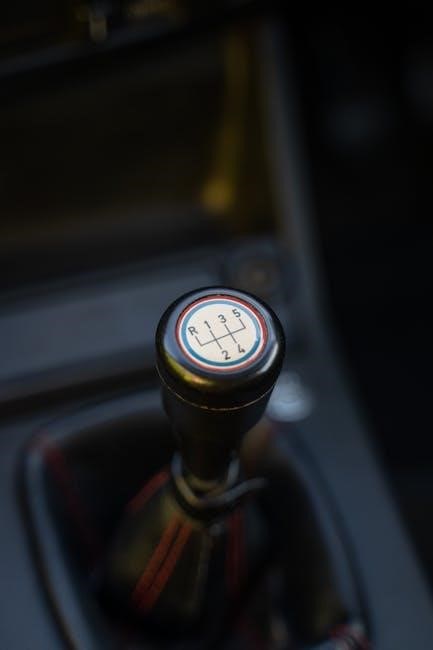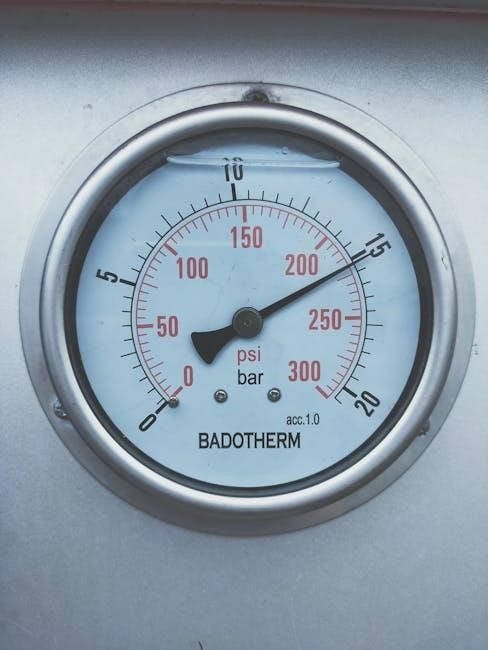The Canon EOS 40D is a high-performance DSLR camera designed for photography enthusiasts and professionals. It features a 10.1MP APS-C CMOS sensor, DIGIC III image processor, and Live View functionality, offering excellent image quality and versatility. With its robust build, intuitive controls, and advanced shooting modes, the EOS 40D is ideal for capturing stunning photos in various conditions, making it a reliable choice for both amateur and experienced photographers.
1.1 Overview of the Camera
The Canon EOS 40D is a high-performance DSLR camera featuring a 10.1MP APS-C CMOS sensor and DIGIC III image processor. It offers a wide ISO range of 100-1600, continuous shooting at 6.5 fps, and a dust reduction system. The camera boasts a weather-sealed magnesium alloy body, a 3-inch LCD screen with Live View, and compatibility with EF and EF-S lenses, making it versatile for various photography needs.
1.2 Key Features of the Canon EOS 40D
The Canon EOS 40D boasts a 10.1MP APS-C CMOS sensor and DIGIC III image processor, delivering sharp images with excellent color accuracy. It supports continuous shooting at 6.5 fps and offers a wide ISO range of 100-1600. The camera features a weather-sealed magnesium alloy body, a 3-inch LCD screen with Live View, and compatibility with EF and EF-S lenses, ensuring versatility for various photography applications and conditions.
1.3 Target Audience
The Canon EOS 40D is aimed at photography enthusiasts and semi-professionals seeking advanced features without the high cost of full-frame cameras. Hobbyists and intermediate photographers benefit from its intuitive controls and manual options. Professionals looking for a reliable secondary camera also appreciate its durability and performance. The user manual is designed to help all users unlock the camera’s full potential, ensuring optimal results in various shooting scenarios and photography styles.

Design and Layout of the Canon EOS 40D
The Canon EOS 40D features a magnesium alloy body, offering durability and lightweight portability. Its ergonomic design and intuitive control layout enhance usability, while the 3.0-inch LCD screen provides clear image previews and playback.
2.1 Ergonomic Design
The Canon EOS 40D boasts a magnesium alloy body, ensuring durability while maintaining a lightweight design. Its contoured grip and balanced weight distribution provide comfort during extended shooting sessions. The camera’s ergonomic layout places controls intuitively, allowing easy access to frequently used functions. This design caters to photographers of all hand sizes, reducing fatigue and enhancing usability.
The weather-sealed construction adds protection against dust and moisture, making it suitable for outdoor use. The overall design emphasizes comfort and functionality, ensuring a secure and comfortable hold for precise control over camera settings.
2.2 Button and Control Layout
The Canon EOS 40D features a well-organized button layout, ensuring intuitive access to primary functions. The mode dial on the top allows quick switching between shooting modes, while the multi-controller enables easy menu navigation and AF point selection. Dedicated buttons for ISO, white balance, and autofocus modes are strategically placed for quick adjustments. The Quick Control Dial simplifies aperture and shutter speed adjustments, enhancing operational efficiency during shooting sessions.
The ergonomic placement of the AF-ON button and the top LCD panel further enhance usability, providing instant access to critical settings and shooting information.
2.3 LCD Screen Features
The Canon EOS 40D features a 3.0-inch LCD screen with a 230,000-dot resolution, providing clear and detailed image previews. The screen supports Live View mode, allowing real-time preview of compositions. Additional features include a histogram display, shooting information overlay, and a grid display option for precise framing. The LCD also offers brightness adjustment, ensuring visibility in various lighting conditions. These features enhance the camera’s usability and help photographers refine their shots effectively.
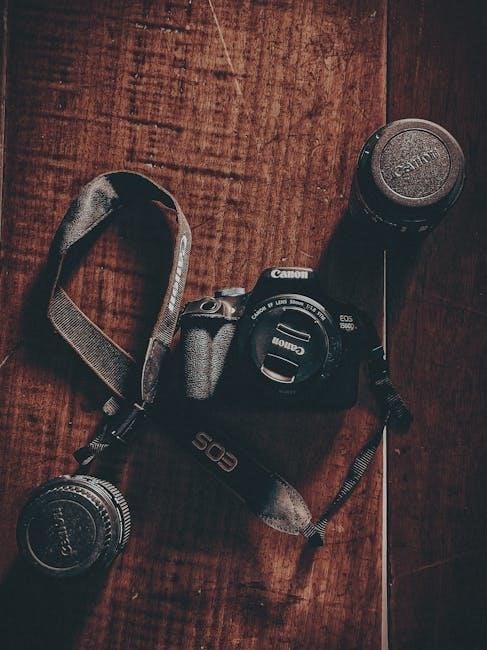
Technical Specifications of the Canon EOS 40D
The Canon EOS 40D features a 10.1MP APS-C CMOS sensor, DIGIC III processor, ISO 100-1600 range, and 6.5fps continuous shooting. It supports SD/SDHC cards and offers a buffer capacity for RAW files, ensuring smooth performance in various shooting scenarios. These specs make it a robust tool for capturing high-quality images with precision and speed.
3.1 Sensor and Image Processor
The Canon EOS 40D is equipped with a 10.1-megapixel APS-C CMOS sensor, designed to deliver high-resolution images with excellent detail and color accuracy. Paired with the advanced DIGIC III image processor, it enhances image quality by improving noise reduction, color rendering, and processing speed. This combination ensures that the camera performs well in various lighting conditions, producing crisp and vibrant photos that meet professional standards. The sensor and processor work together seamlessly to optimize image capture and processing efficiency.
3.2 ISO Range and Noise Performance
The Canon EOS 40D offers an ISO range of 100 to 1600, expandable to 3200 in extended mode, ensuring flexibility in various lighting conditions. The DIGIC III processor effectively minimizes noise, delivering clean images even at higher ISO settings. While noise is more noticeable at ISO 1600 and above compared to modern standards, the EOS 40D still performs admirably for its class, providing detailed and usable photos across its ISO spectrum.
3.3 Continuous Shooting and Buffer Capacity
The Canon EOS 40D offers continuous shooting at up to 6.5 frames per second, making it suitable for capturing dynamic action sequences. The buffer capacity allows for 75 JPEG images or 17 RAW images when using a high-speed memory card, ensuring uninterrupted shooting sessions. The camera supports both CF and SD memory cards, providing flexibility and convenience in managing storage needs during photography sessions, enhancing overall productivity and efficiency.

Getting Started with the Canon EOS 40D
Unbox the EOS 40D, ensuring all accessories like the battery, charger, and memory cards are included. Charge the battery fully before first use and insert a memory card. Follow the initial setup guide to configure language, date, and time settings. Check for firmware updates to ensure optimal performance and refer to the manual for detailed instructions on initial configuration and customization options;
4.1 Unboxing and Accessories
Upon unboxing the Canon EOS 40D, you’ll find the camera body, rechargeable lithium-ion battery, LC-E6 charger, Eyecup Eb, wide neck strap, and Interface Cable IFC-200U. Additionally, a 16GB memory card is recommended for storing images. Ensure all items are included and inspect for damage. Familiarize yourself with each accessory, as they are essential for camera operation. Refer to the manual for details on proper handling and usage of included components to get started with your photography journey.
4.2 Charging the Battery and Memory Cards
The Canon EOS 40D comes with a rechargeable lithium-ion battery (Model LP-E6). To charge, use the provided LC-E6 charger, ensuring the battery is fully charged for approximately 2 hours. For memory cards, format the card in the camera before use to ensure compatibility. The EOS 40D supports CF (CompactFlash) and SD/SDHC cards. Always use high-speed cards for optimal performance. Charge the battery and prepare memory cards before your first shoot to avoid interruptions.
4.3 Initial Setup and Firmware Updates
After unboxing, set your language, date, and time in the menu. Format the memory card to ensure optimal performance. For firmware updates, use EOS Utility on your computer. Connect the camera, download the latest firmware, and follow on-screen instructions. Avoid interrupting the update to prevent damage. Updates enhance camera performance and add new features.
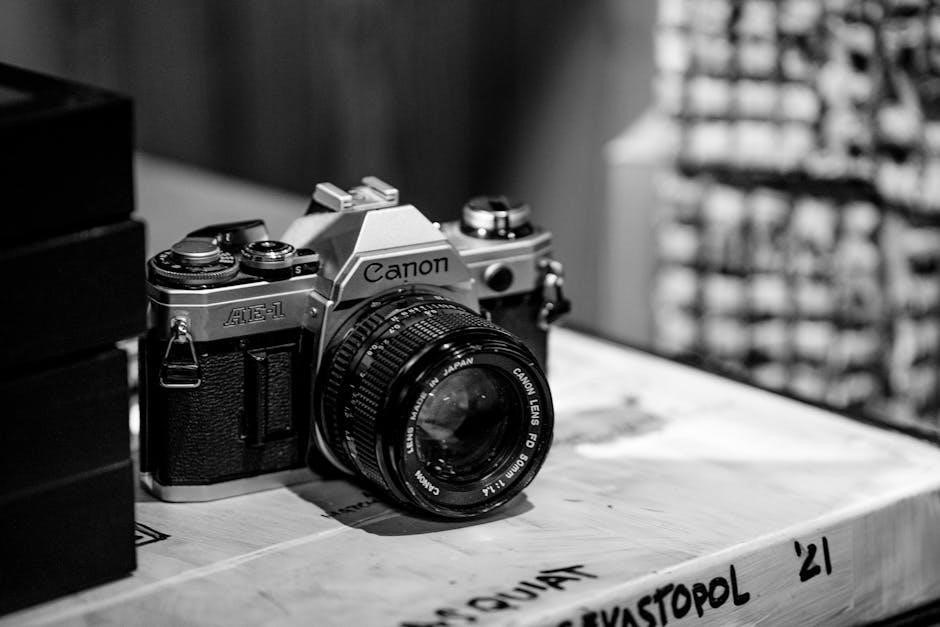
Using the Canon EOS 40D
The EOS 40D offers intuitive shooting modes, including Auto, Manual, Aperture Priority, and Shutter Priority. Use Live View for precise composition and capture up to 6.5 fps in burst mode for dynamic action shots.
5.1 Shooting Modes (Auto, Manual, Aperture Priority, Shutter Priority)
The Canon EOS 40D offers versatile shooting modes to suit different photography needs. Auto mode simplifies shooting for beginners, while Manual mode provides full creative control. Aperture Priority (Av) allows adjusting the aperture to control depth of field, and Shutter Priority (Tv) enables manual shutter speed adjustment to capture motion effects. These modes empower photographers to tailor settings for optimal results in various lighting conditions and creative scenarios.
5.2 Autofocus and Metering Modes
The Canon EOS 40D features advanced autofocus and metering systems for precise control. Autofocus modes include One-Shot AF for stationary subjects and AI Servo AF for tracking moving objects. Metering options like Evaluative, Center-Weighted, and Spot ensure accurate exposure in various lighting conditions. These modes allow photographers to customize focus and exposure settings, enhancing the quality of their images and adapting to diverse shooting scenarios effectively.
5.3 Exposure Compensation and White Balance
The Canon EOS 40D offers precise control over exposure compensation, allowing adjustments of ±3 stops in 1/3-stop increments. White balance settings include Auto, Daylight, Shade, Tungsten, Fluorescent, Flash, and Custom options, ensuring accurate color rendition in various lighting conditions. These features enable photographers to fine-tune their images for optimal brightness and color accuracy, enhancing the overall quality of their shots in both automatic and manual shooting modes.
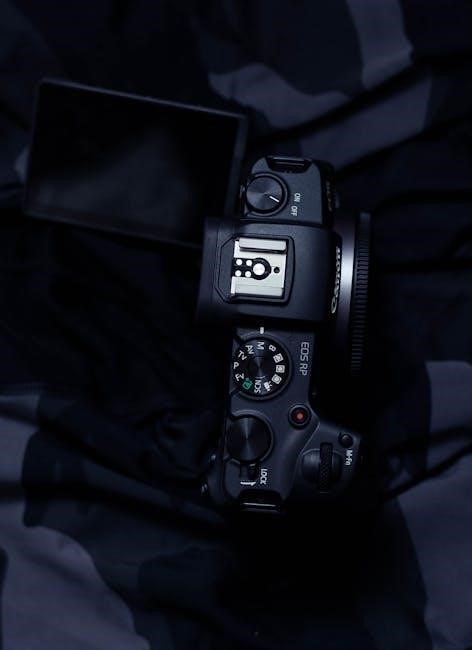
Customizing the Canon EOS 40D
The Canon EOS 40D allows extensive customization through custom functions, My Menu setup, and personalized shooting preferences, enabling users to tailor the camera to their specific needs and shooting styles for enhanced creativity and efficiency.
6.1 Custom Functions and Settings
The Canon EOS 40D offers a range of custom functions that allow users to personalize camera settings. These include options for autofocus, metering modes, and exposure controls. Users can adjust settings like autofocus point selection, ISO increments, and custom white balance presets. Additionally, the camera permits customization of button functions, enabling photographers to tailor controls to their preferences. This flexibility enhances workflow efficiency and ensures a more intuitive shooting experience.
6.2 My Menu Setup
The Canon EOS 40D’s My Menu feature allows users to create a personalized menu with up to six frequently used settings. Accessible via the camera’s menu system, My Menu streamlines workflow by enabling quick adjustments to preferred options. Users can register, organize, and easily access their most-used functions, enhancing efficiency during shooting sessions. This customization option ensures that photographers can tailor their camera to suit their individual needs and shooting styles effectively.
6.3 Personalizing Shooting Preferences
The Canon EOS 40D allows users to tailor shooting preferences to their creative vision. Picture Styles enable customization of color profiles, contrast, and sharpness, with options like Standard, Portrait, and Landscape. Additionally, custom functions can be assigned to buttons, and white balance settings can be fine-tuned or saved for specific lighting conditions. These personalization options empower photographers to adapt the camera to their unique needs, ensuring optimal results in diverse shooting scenarios.
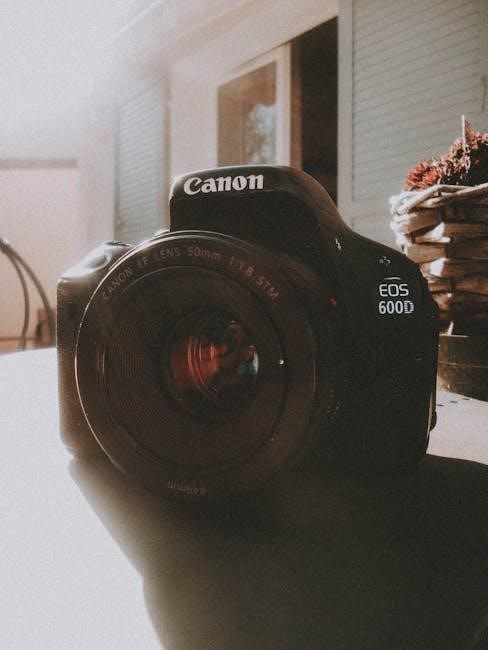
Image Quality and Settings
The Canon EOS 40D delivers exceptional image quality with customizable settings. RAW and JPEG formats are supported, allowing for flexible post-processing. Picture Styles enable tailored color profiles, while noise reduction ensures crisp images in low-light conditions, making it ideal for photographers seeking precision and creativity in their work.
7.1 RAW vs. JPEG File Formats
The Canon EOS 40D supports both RAW and JPEG file formats, each offering unique advantages. RAW files capture all sensor data, providing maximum flexibility for post-processing, while JPEG files are smaller, processed in-camera, and ready for immediate use. RAW is ideal for professionals seeking precise control, whereas JPEG suits casual shooters needing convenience. The EOS 40D allows simultaneous RAW+JPEG capture, ensuring versatility for diverse photographic needs.
7.2 Picture Styles and Color Profiles
The Canon EOS 40D offers customizable Picture Styles, allowing users to adjust settings like sharpness, contrast, and color tone to suit their creative vision. These styles include Standard, Portrait, Landscape, Neutral, Faithful, and Monochrome. Additionally, the camera supports color profiles, ensuring consistent color representation across devices. Users can customize Picture Styles or create new ones, providing flexibility for photographers seeking precise control over their images’ aesthetic and professional-grade color accuracy.
7.3 Noise Reduction and Image Optimization
The Canon EOS 40D features built-in noise reduction for high ISO settings, minimizing grain in low-light images. Users can customize noise reduction levels or disable it for finer control. Additionally, the camera supports in-camera image optimization tools, allowing adjustments to contrast, saturation, and sharpness. These features, combined with RAW image capture, enable photographers to refine their images directly in the camera, ensuring optimal quality and reducing post-processing needs.

Maintenance and Care
Regular maintenance ensures optimal performance of your Canon EOS 40D. Clean the sensor and lens with approved tools to prevent dust buildup. Store the camera in a dry, cool place to avoid moisture damage. Update firmware periodically to access the latest features and improvements, ensuring your camera operates at its best.
8.1 Cleaning the Sensor and Lens
Regularly clean the Canon EOS 40D’s sensor and lens to maintain image quality. Use a soft brush or bulb blower to remove dust from the sensor. For stubborn spots, dampen a microfiber cloth with cleaning solution and gently wipe the lens. Avoid touching the sensor surface to prevent damage. Clean the lens regularly to reduce smudges and fingerprints. Store the camera with a UV filter to protect the lens from dust and scratches.
8.2 Storing the Camera Properly
Store your Canon EOS 40D in a cool, dry place to prevent moisture and humidity damage. Use a protective case or bag to shield it from dust and physical damage. Keep the lens capped when not in use and attach a UV filter for added protection. Avoid extreme temperatures and direct sunlight. Store the battery separately in a cool, dry location to maintain its performance. Use silica gel packets to absorb moisture in storage areas.
8.3 Updating Firmware
Regularly update your Canon EOS 40D’s firmware to ensure optimal performance and access to new features. Visit Canon’s official website to download the latest firmware version. Use the EOS Utility software to transfer and install the update. Ensure the camera’s battery is fully charged before starting. Avoid interrupting the update process, as it may damage the camera. Follow the on-screen instructions carefully to complete the firmware update successfully.

Troubleshooting Common Issues
Resolve common issues like error messages, autofocus problems, and exposure errors by referring to the Canon EOS 40D user manual or Canon’s official support resources.
9.1 Error Messages and Solutions
The Canon EOS 40D may display error messages like “Err 99” or “Card Error.” These issues often relate to faulty memory cards, lens communication problems, or sensor malfunctions. To resolve “Err 99,” clean the sensor or reset the camera. For “Card Error,” format the memory card or replace it. Refer to the user manual or Canon’s support website for detailed solutions and troubleshooting guides to address these common issues effectively.
9.2 Resolving Autofocus Problems
Autofocus issues with the Canon EOS 40D can often be resolved by cleaning the lens and sensor to remove dirt or smudges. Ensure the AF mode is set correctly for your subject, and check that the lens is properly attached. If focusing remains inaccurate, reset the camera to default settings or perform a hard reset by removing the battery and memory card. Consult the user manual or Canon support for advanced troubleshooting steps to restore optimal autofocus performance.
9.3 Fixing Exposure and White Balance Issues
To address exposure issues, reset the camera settings to default or use the exposure compensation feature. For white balance problems, ensure the correct preset is selected or use custom white balance by shooting a reference object. Check the histogram to verify exposure accuracy. If issues persist, consult the user manual for advanced troubleshooting or update the firmware to ensure optimal performance and accurate color representation in your photos.
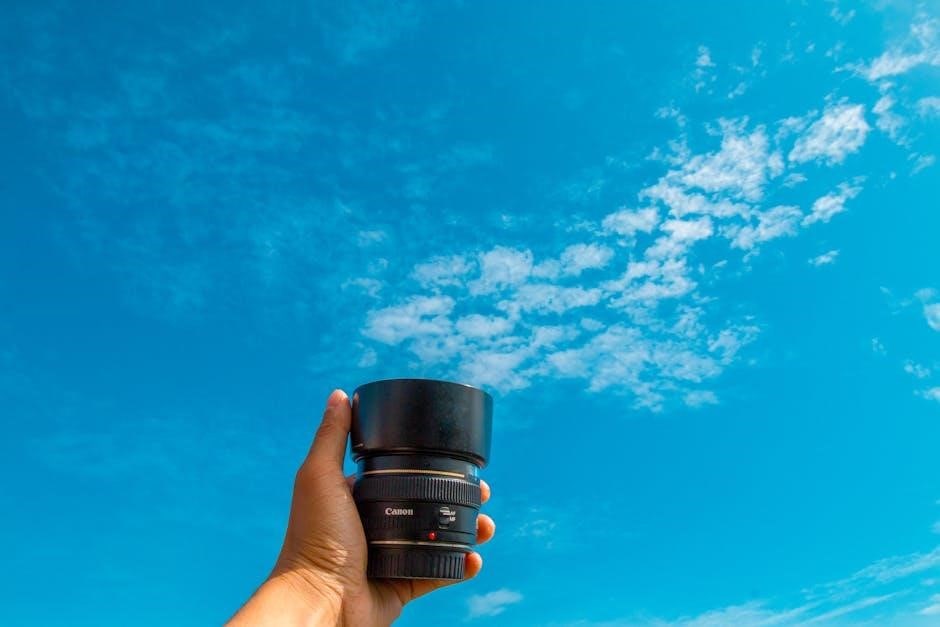
Downloading and Installing Software
Download Canon EOS 40D software, including EOS Utility and Digital Photo Professional, from the official Canon website. Ensure compatibility with your operating system for smooth installation and functionality.
10.1 EOS Utility and Digital Photo Professional
EOS Utility enables remote camera control and image transfer, while Digital Photo Professional allows RAW file editing. Both are essential for enhancing workflow. Download these tools from Canon’s official website to ensure compatibility with your operating system. Proper installation guarantees seamless functionality, enabling you to manage and edit photos efficiently with the Canon EOS 40D.
10.2 ImageBrowser and Other Canon Software
ImageBrowser is a powerful tool for managing and editing images from your Canon EOS 40D. It allows browsing, organizing, and transferring photos from the camera to your computer. Additional Canon software includes Digital Photo Professional for RAW file editing and EOS Utility for remote camera control. These tools enhance your workflow, enabling seamless photo management and editing. Download them from Canon’s official website for optimal compatibility and performance with your EOS 40D.
10.4 Troubleshooting Software Installation
When installing Canon EOS 40D software, ensure you download from official sources to avoid malware. Check system compatibility and restart your computer post-installation. Use administrator privileges to prevent permission issues. If software doesn’t recognize the camera, reinstall drivers and ensure proper USB connections. Consult the user manual or Canon support for further assistance. These steps help resolve common installation problems effectively.
The Canon EOS 40D is a robust DSLR offering exceptional image quality and durability. This manual provides comprehensive guidance to unlock its full potential and enhance your photography experience.
11.1 Summary of Key Features
The Canon EOS 40D offers a 10.1MP APS-C CMOS sensor, DIGIC III image processor, and ISO 100-1600 range, delivering sharp images with minimal noise. It features 6.5fps continuous shooting, a 3.0-inch LCD, and 9-point AF for precise focus. The camera supports RAW and JPEG formats, Picture Styles, and Live View, making it versatile for various photography needs. Its ergonomic design and weather-sealing ensure durability, while advanced settings allow for customization and optimal performance.
11.2 Final Tips for Getting the Most Out of the Canon EOS 40D
To maximize your Canon EOS 40D experience, experiment with shooting modes like Manual, Aperture Priority, and Shutter Priority for creative control. Utilize Custom Functions to tailor settings to your workflow. Regularly clean the sensor and update firmware for optimal performance. Shoot in RAW for enhanced post-processing flexibility. Familiarize yourself with White Balance and Picture Styles to refine image quality. Practice with different lighting conditions and compositions to unlock the camera’s full potential.


